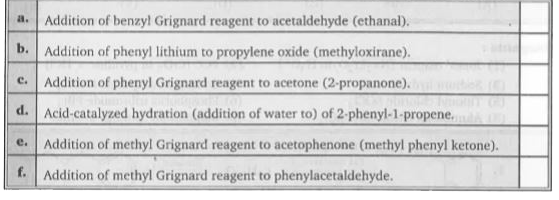Which of the following methods would not serve to prepare 1-phenylpropan -2-ol.
Addition of benzyl grignard reagent to ethanal
Addition of phenyllithium to methyloxirane
Addition of methyl grignard reagent to phenyl acetaldehyde.
Addition of phenyl magnesium bromide with ethanal.
The correct Answer is:A, B, C
To determine which method would not serve to prepare 1-phenylpropan-2-ol, we need to analyze each of the given options.
1. Understanding the Target Compound:
- The target compound is 1-phenylpropan-2-ol, which has the structure:
C6H5CH(CH3)OH
- This indicates that we need a phenyl group (C6H5) attached to a carbon that is also attached to a hydroxyl (-OH) group, and that carbon must be connected to another carbon (the propan part).
2. Analyzing the First Option:
- Benzyl Grignard Reagent: This reagent can be represented as C6H5CH2MgBr. When it reacts with a carbonyl compound (like acetone), it can form the desired alcohol after hydrolysis.
- The reaction would yield 1-phenylpropan-2-ol.
- Conclusion: This method works.
3. Analyzing the Second Option:
- Addition of Phenyl Lithium to Methyl Oxyrene:
- Phenyl lithium (C6H5Li) can add to methyl oxyrene (C6H5OCH3), resulting in a compound that can be hydrolyzed to form 1-phenylpropan-2-ol.
- Conclusion: This method works.
4. Analyzing the Third Option:
- Addition of Methyl Grignard Reagent to Phenyl Acetaldehyde:
- Methyl Grignard (CH3MgBr) will react with phenyl acetaldehyde (C6H5CHO) to form a secondary alcohol after hydrolysis.
- The product will be 1-phenylpropan-2-ol.
- Conclusion: This method works.
5. Analyzing the Fourth Option:
- Addition of Phenyl Magnesium Bromide with Ethanol:
- Phenyl magnesium bromide (C6H5MgBr) is a Grignard reagent. If it reacts with ethanol, it would not form the desired product. Instead, it would lead to an unstable intermediate and likely yield a different alcohol (like 1-phenylethanol).
- Conclusion: This method does NOT work.
Final Answer:
The method that would not serve to prepare 1-phenylpropan-2-ol is Option D: Addition of Phenyl Magnesium Bromide with Ethanol.
---
- The target compound is 1-phenylpropan-2-ol, which has the structure:
C6H5CH(CH3)OH
- This indicates that we need a phenyl group (C6H5) attached to a carbon that is also attached to a hydroxyl (-OH) group, and that carbon must be connected to another carbon (the propan part).
- Benzyl Grignard Reagent: This reagent can be represented as C6H5CH2MgBr. When it reacts with a carbonyl compound (like acetone), it can form the desired alcohol after hydrolysis.
- The reaction would yield 1-phenylpropan-2-ol.
- Conclusion: This method works.
- Addition of Phenyl Lithium to Methyl Oxyrene:
- Phenyl lithium (C6H5Li) can add to methyl oxyrene (C6H5OCH3), resulting in a compound that can be hydrolyzed to form 1-phenylpropan-2-ol.
- Conclusion: This method works.
- Addition of Methyl Grignard Reagent to Phenyl Acetaldehyde:
- Methyl Grignard (CH3MgBr) will react with phenyl acetaldehyde (C6H5CHO) to form a secondary alcohol after hydrolysis.
- The product will be 1-phenylpropan-2-ol.
- Conclusion: This method works.
- Addition of Phenyl Magnesium Bromide with Ethanol:
- Phenyl magnesium bromide (C6H5MgBr) is a Grignard reagent. If it reacts with ethanol, it would not form the desired product. Instead, it would lead to an unstable intermediate and likely yield a different alcohol (like 1-phenylethanol).
- Conclusion: This method does NOT work.
The method that would not serve to prepare 1-phenylpropan-2-ol is Option D: Addition of Phenyl Magnesium Bromide with Ethanol.
Topper's Solved these Questions
- CARBONYL COMPOUNDS (ALDEHYDES & KETONES ) & CARBOXYLIC ACID BOOK - RESONANCE ENGLISHCHAPTER - CARBONYL COMPOUNDS (ALDEHYDES & KETONES ) & CARBOXYLIC ACID EXERCISE - Part -III
31 Videos
- BIOMOLECULES & POLYMERBOOK - RESONANCE ENGLISHCHAPTER - BIOMOLECULES & POLYMEREXERCISE - ORGANIC CHEMISTRY(Biomolecules & Polymer)
34 Videos
- CHEMICAL KINETICSBOOK - RESONANCE ENGLISHCHAPTER - CHEMICAL KINETICSEXERCISE - PHYSICAL CHEMITRY (CHEMICAL KNIETICS & RADIOACTIVITY)
49 Videos
Similar Questions
Knowledge Check
Which of the following cannot serve as a vegetative propagule ?
AOrganismMode of multiplicationAgave, Oxalis BulbilsBOrganismMode of multiplicationAmoeba, Paramecium Binary fissionCOrganismMode of multiplicationChlamydomones, Ulothrix SporangiosporesDOrganismMode of multiplicationAdiantum caudatum Adventitou buds present at leaf tips
Which of the following reactions would give pentan−2−ol ?
View SolutionWhich of the following methods is (are) used to prepare colloidal sols?
View SolutionWhich of the following methods could be employed for the preparation of As2S3 yolo sol?
View SolutionWhich of the following reduction methods is not suitable for
preparing an alcohol ?
View SolutionWhich of the following methods can be used for the preparation of anhydrous aluminium chloride
View SolutionWhich of the following serves as an stop codon ?
View SolutionWrite the structure of 1-phenylpropan-1-ol .
View Solution

